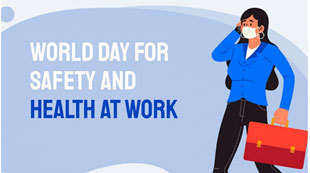
COMMENT | Lydia Mirembe | A story is told of a young factory worker, whose hands were crushed as he operated a machine in the factory. Having lost both hands, he could not carry on with his job, and was forced to take early retirement. His employer sent him home with prosthetic hands and a paltry compensation. The young man lived with his disability to a ripe old age. Needless to say, it was not a happy-ever-after kind of life. It all boiled down to workplace health and safety.
On a regular basis, situations relating to workplace health and safety play out in our midst. Workers are exposed to a wide range of risks such as: diseases caused by chemical, physical, or biological agents; respiratory diseases, skin diseases, cancers, physical injuries, musculoskeletal disorders, and work-related mental and behavioural disorders.
On Friday 28th April, the United Nations marked the International Day for Safety and Health at Work under the theme: “A safe and healthy working environment is a fundamental principle and right at work”.

According to the International Labour Organisation (ILO), an estimated 160 million people suffer from occupational diseases while and 2.3 million die every year as a result of work-related accidents and diseases. Moreover, many workplace accidents and injuries go unreported. Where the injuries and effects are not quickly realized, it may even be difficult to trace them back to work-related causes.
Health and safety hazards in the workplace lead to human and economic costs, and the brunt is mostly borne by the workers and their families. For example, injured workers lose wages and incur medical expenses which may not be covered under workplace insurance arrangements. Injured workers may not be available to serve their families and communities due to incapacitation or even death.
Similarly, the employer may incur losses arising from work-related safety or health situations. Production processes are interrupted; employee morale and productivity plummet; additional costs incurred to recruit and replace injured workers; and not to forget the reputational risk for the company.
From a retirement planning perspective, it is worth noting that the ultimate impact of workplace health and safety conditions manifests many years later, affecting the injured worker’s physical and financial wellbeing in retirement.
Take the example of occupational diseases which can arise from exposure to hazardous substances such as chemicals or dust. These diseases may not manifest until many years after exposure, which can have severe implications for workers’ health in their old age. Workers exposed to physical or psychological stressors in the workplace may be at higher risk of developing chronic health conditions such as heart disease, diabetes, or mental health disorders. Workers who experience physical injuries, such as back or repetitive strain injuries, may develop chronic pain or limited mobility in old age. These conditions can affect the worker’s ability to carry out daily activities, may require costly medical treatment or rehabilitation, reducing the quality of life in old age.
Employers do well to support their employees to save and plan for retirement by contributing to mandatory or occupational schemes. However, they should also look beyond the monetary aspects of their employees’ retirement planning. Employers should provide a safe and healthy working environment, while employees take steps to protect their own health and safety in the workplace. Both employers and employees should follow the standard safe practices as prescribed in the national laws, policies and guidelines such as The Occupational Safety and Health Act 2006 and the National Policy on Occupational Safety and Health. The Ministry of Gender, Labour and Social Development has also developed guidelines on workplace safety and health that provide practical guidance on how to implement the provisions of the Occupational Safety and Health Act.
International Day for Safety and Health at Work came just two days before the commemoration of International Labour Day, on 1st May. Both days provide an opportune moment to reflect on the long-term implications of health and safety in the workplace. In the ideal environment, workers should be protected from hazards and risks that may arise from their work. They should be provided with the necessary facilities and resources that promote their physical, mental, and social well-being. Employers should provide simple things like adequate lighting and ventilation, clean and hygienic facilities, access to healthcare services, training and education of workers to help them identify potential hazards and risks.
Workers should not sacrifice their health and safety in the pursuit of work-related gains, only to later lose those gains as they try to reclaim their health.
Happy Labour Day!
*****
 Lydia Mirembe is the Manager, Corporate and Public Affairs, Uganda Retirement Benefits Regulatory Authority (URBRA)
Lydia Mirembe is the Manager, Corporate and Public Affairs, Uganda Retirement Benefits Regulatory Authority (URBRA)
 The Independent Uganda: You get the Truth we Pay the Price
The Independent Uganda: You get the Truth we Pay the Price



